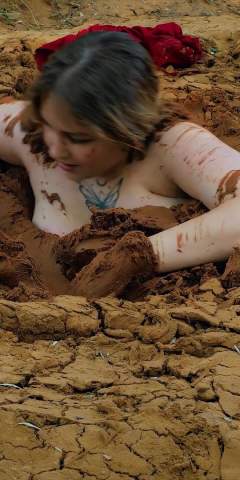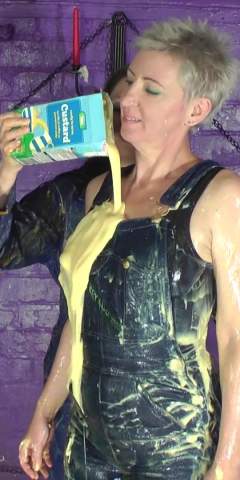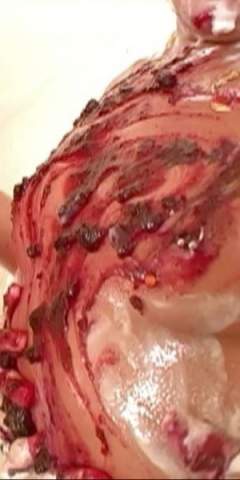The Mud I use is Pottery Clay
By Muddddy
By Muddddy
Posted 9/28/25 98 views
I'm often asked what do I use in my videos and pictures, and where do I buy it from. I almost exclusively play with mud, as that's what floats my boat. The alure of natural mud is the most exciting, but most often it comes with unwanted extra's, such as twigs, stones, grit, grass, leaves, etc. Whilst still being able to enjoy it, I've found that the hard or sharp bits made it difficult to fully enjoy as it is unpleasant to rub into your face. I've been scratched and received minor cuts from "real" mud. Then you discover that clay is wonderfully creamy, has the perfect texture and clinginess, and doesn't tend to have many stones in it.
Naturally occurring clay pits do exist but not anywhere near where I live, so I started to buy pottery clay instead. It makes amazing mud - not convinced, watch my videos! I long time ago, I'd buy the odd packet, which consisted of 12.5kg of moist but firm clay, but for a period I bought 10kg packets from Amazon for convenience (the largest quantity I could find). Whilst having a wonderful texture and making amazing mud, there was never enough of it and buying larger quantities from Amazon wasn't possible and too expensive, so I've reverted back to buying clay from a pottery supplier.
This is what I currently use:
2 x 12.5kg of buff grey clay - Vitraclay School and Studio All Purpose Clay, SKU: VC03-12.5KG
1 x 12.5kg of terracotta clay - Vitraclay Terracotta Clay, SKU: VC09-12.5KG
I buy them from a supplier called 'hot-clay.com'. The irony isn't lost on me! Clay is clay, so use the closest supplier to where you live.
Mix 3 to 4 litres of water per 12.5kg bag. The above makes approximately 50kg of mud - I have two 30l barrels that when full holds 100kg of mud between them, clearly I've doubled up the quantities above. Terracotta clay is very orange in colour and stains bathroom grout quite badly. Buff clay is grey and does not stain nearly as bad. I've tried both but always yearned for it to look like farm mud, which orange and grey do not. I've found that mixing two buff to one terracotta bag of clay makes the pleasing brown colour I was looking for.
The most important thing to look out for is grogged clay, as you want to avoid this. Bits or sand are added to grogged clay to give it more body to make it hold the structure of the pot you're making. This is the opposite of what you want if you want to turn it into mud! Smooth clay is what you want and, fortunately, the cheapest clay is usually really smooth and grog free. I also avoid air-drying clay, as I want it to stay wet as long as possible, mud is better when it's not dried out!
So, there you have it. If you want the smoothest of mud then try clay. And when you find you want more than a little, use a local pottery supplier, and laugh when you get sent special offers for kilns and other pottery paraphernalia.
Naturally occurring clay pits do exist but not anywhere near where I live, so I started to buy pottery clay instead. It makes amazing mud - not convinced, watch my videos! I long time ago, I'd buy the odd packet, which consisted of 12.5kg of moist but firm clay, but for a period I bought 10kg packets from Amazon for convenience (the largest quantity I could find). Whilst having a wonderful texture and making amazing mud, there was never enough of it and buying larger quantities from Amazon wasn't possible and too expensive, so I've reverted back to buying clay from a pottery supplier.
This is what I currently use:
2 x 12.5kg of buff grey clay - Vitraclay School and Studio All Purpose Clay, SKU: VC03-12.5KG
1 x 12.5kg of terracotta clay - Vitraclay Terracotta Clay, SKU: VC09-12.5KG
I buy them from a supplier called 'hot-clay.com'. The irony isn't lost on me! Clay is clay, so use the closest supplier to where you live.
Mix 3 to 4 litres of water per 12.5kg bag. The above makes approximately 50kg of mud - I have two 30l barrels that when full holds 100kg of mud between them, clearly I've doubled up the quantities above. Terracotta clay is very orange in colour and stains bathroom grout quite badly. Buff clay is grey and does not stain nearly as bad. I've tried both but always yearned for it to look like farm mud, which orange and grey do not. I've found that mixing two buff to one terracotta bag of clay makes the pleasing brown colour I was looking for.
The most important thing to look out for is grogged clay, as you want to avoid this. Bits or sand are added to grogged clay to give it more body to make it hold the structure of the pot you're making. This is the opposite of what you want if you want to turn it into mud! Smooth clay is what you want and, fortunately, the cheapest clay is usually really smooth and grog free. I also avoid air-drying clay, as I want it to stay wet as long as possible, mud is better when it's not dried out!
So, there you have it. If you want the smoothest of mud then try clay. And when you find you want more than a little, use a local pottery supplier, and laugh when you get sent special offers for kilns and other pottery paraphernalia.
Labeled male
| Muddddy's blog & stories | Followpost | All blogs |
 |  |  |
Sponsors
Design & Code ©1998-2025 Loverbuns, LLC 18 U.S.C. 2257 Record-Keeping Requirements Compliance Statement
Epoch Billing Support Log In






 Love you, too
Love you, too







